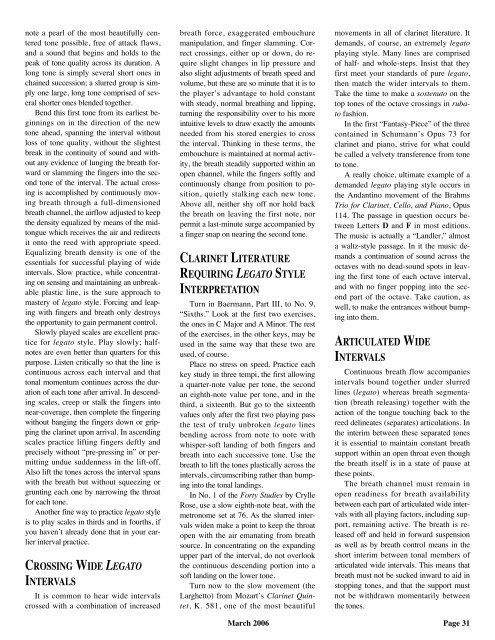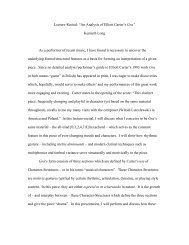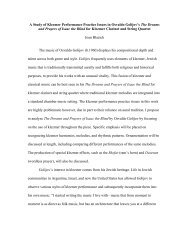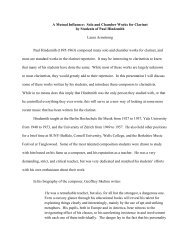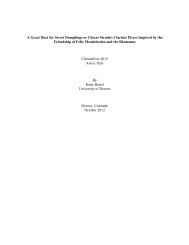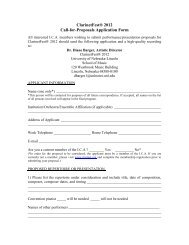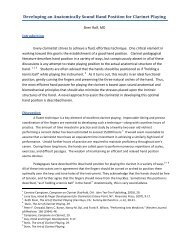Buffet Crampon's - International Clarinet Association
Buffet Crampon's - International Clarinet Association
Buffet Crampon's - International Clarinet Association
You also want an ePaper? Increase the reach of your titles
YUMPU automatically turns print PDFs into web optimized ePapers that Google loves.
note a pearl of the most beautifully centered<br />
tone possible, free of attack flaws,<br />
and a sound that begins and holds to the<br />
peak of tone quality across its duration. A<br />
long tone is simply several short ones in<br />
chained succession; a slurred group is simply<br />
one large, long tone comprised of several<br />
shorter ones blended together.<br />
Bend this first tone from its earliest be -<br />
ginnings on in the direction of the new<br />
tone ahead, spanning the interval without<br />
loss of tone quality, without the slightest<br />
break in the continuity of sound and without<br />
any evidence of lunging the breath forward<br />
or slamming the fingers into the second<br />
tone of the interval. The actual crossing<br />
is accomplished by continuously moving<br />
breath through a full-dimensioned<br />
breath channel, the airflow adjusted to keep<br />
the density equalized by means of the midtongue<br />
which receives the air and redirects<br />
it onto the reed with appropriate speed.<br />
Equalizing breath density is one of the<br />
essentials for successful playing of wide<br />
intervals. Slow practice, while concentrating<br />
on sensing and maintaining an un break -<br />
able plastic line, is the sure ap proach to<br />
mastery of legato style. Forcing and leap -<br />
ing with fingers and breath only destroys<br />
the opportunity to gain permanent control.<br />
Slowly played scales are excellent practice<br />
for legato style. Play slowly; halfnotes<br />
are even better than quarters for this<br />
purpose. Listen critically so that the line is<br />
continuous across each interval and that<br />
tonal momentum continues across the dur -<br />
ation of each tone after arrival. In descending<br />
scales, creep or stalk the fingers into<br />
near-coverage, then complete the fingering<br />
without banging the fingers down or gripping<br />
the clarinet upon arrival. In ascending<br />
scales practice lifting fingers deftly and<br />
precisely without “pre-pressing in” or permitting<br />
undue suddenness in the lift-off.<br />
Also lift the tones across the interval spans<br />
with the breath but without squeezing or<br />
grunting each one by narrowing the throat<br />
for each tone.<br />
Another fine way to practice legato style<br />
is to play scales in thirds and in fourths, if<br />
you haven’t already done that in your ear -<br />
lier interval practice.<br />
CROSSING WIDE LEGATO<br />
INTERVALS<br />
It is common to hear wide intervals<br />
crossed with a combination of increased<br />
breath force, exaggerated embouchure<br />
man ipulation, and finger slamming. Cor -<br />
rect crossings, either up or down, do re -<br />
quire slight changes in lip pressure and<br />
also slight adjustments of breath speed and<br />
volume, but these are so minute that it is to<br />
the player’s advantage to hold constant<br />
with steady, normal breathing and lipping,<br />
turning the responsibility over to his more<br />
in tuitive levels to draw exactly the amounts<br />
needed from his stored energies to cross<br />
the interval. Thinking in these terms, the<br />
embouchure is maintained at normal activity,<br />
the breath steadily supported within an<br />
open channel, while the fingers softly and<br />
continuously change from position to po -<br />
sition, quietly stalking each new tone.<br />
Above all, neither shy off nor hold back<br />
the breath on leaving the first note, nor<br />
permit a last-minute surge accompanied by<br />
a finger snap on nearing the second tone.<br />
CLARINET LITERATURE<br />
REQUIRING LEGATO STYLE<br />
INTERPRETATION<br />
Turn in Baermann, Part III, to No. 9,<br />
“Sixths.” Look at the first two exercises,<br />
the ones in C Major and A Minor. The rest<br />
of the exercises, in the other keys, may be<br />
used in the same way that these two are<br />
used, of course.<br />
Place no stress on speed. Practice each<br />
key study in three tempi, the first allowing<br />
a quarter-note value per tone, the second<br />
an eighth-note value per tone, and in the<br />
third, a sixteenth. But go to the sixteenth<br />
values only after the first two playing pass<br />
the test of truly unbroken legato lines<br />
bending across from note to note with<br />
whisper-soft landing of both fingers and<br />
breath into each successive tone. Use the<br />
breath to lift the tones plastically across the<br />
intervals, circumscribing rather than bumping<br />
into the tonal landings.<br />
In No. 1 of the Forty Studies by Crylle<br />
Rose, use a slow eighth-note beat, with the<br />
metronome set at 76. As the slurred intervals<br />
widen make a point to keep the throat<br />
open with the air emanating from breath<br />
source. In concentrating on the expanding<br />
upper part of the interval, do not overlook<br />
the continuous descending portion into a<br />
soft landing on the lower tone.<br />
Turn now to the slow movement (the<br />
Larghetto) from Mozart’s <strong>Clarinet</strong> Quin -<br />
tet, K. 581, one of the most beautiful<br />
movements in all of clarinet literature. It<br />
demands, of course, an extremely legato<br />
playing style. Many lines are comprised<br />
of half- and whole-steps. Insist that they<br />
first meet your standards of pure legato,<br />
then match the wider intervals to them.<br />
Take the time to make a sostenuto on the<br />
top tones of the octave crossings in rubato<br />
fashion.<br />
In the first “Fantasy-Piece” of the three<br />
contained in Schumann’s Opus 73 for<br />
clarinet and piano, strive for what could<br />
be called a velvety transference from tone<br />
to tone.<br />
A really choice, ultimate example of a<br />
demanded legato playing style occurs in<br />
the Andantino movement of the Brahms<br />
Trio for <strong>Clarinet</strong>, Cello, and Piano, Opus<br />
114. The passage in question occurs be -<br />
tween Letters D and F in most editions.<br />
The music is actually a “Landler,” almost<br />
a waltz-style passage. In it the music de -<br />
mands a continuation of sound across the<br />
octaves with no dead-sound spots in leaving<br />
the first tone of each octave interval,<br />
and with no finger popping into the second<br />
part of the octave. Take caution, as<br />
well, to make the entrances without bumping<br />
into them.<br />
ARTICULATED WIDE<br />
INTERVALS<br />
Continuous breath flow accompanies<br />
intervals bound together under slurred<br />
lines (legato) whereas breath segmentation<br />
(breath releasing) together with the<br />
action of the tongue touching back to the<br />
reed delineates (separates) articulations. In<br />
the interim between these separated tones<br />
it is essential to maintain constant breath<br />
support within an open throat even though<br />
the breath itself is in a state of pause at<br />
these points.<br />
The breath channel must remain in<br />
open readiness for breath availability<br />
between each part of articulated wide intervals<br />
with all playing factors, including support,<br />
remaining active. The breath is re -<br />
leased off and held in forward suspension<br />
as well as by breath control means in the<br />
short interim between tonal members of<br />
articulated wide intervals. This means that<br />
breath must not be sucked inward to aid in<br />
stopping tones, and that the support must<br />
not be withdrawn momentarily between<br />
the tones.<br />
March 2006 Page 31


